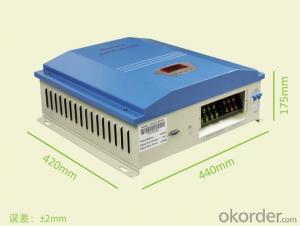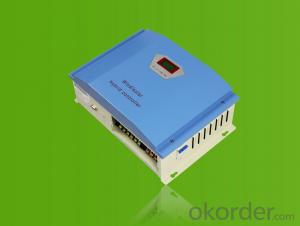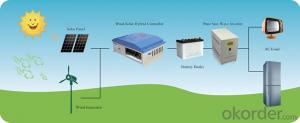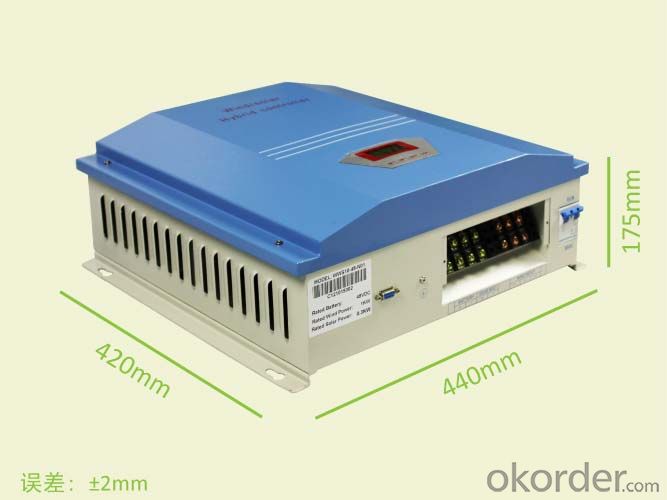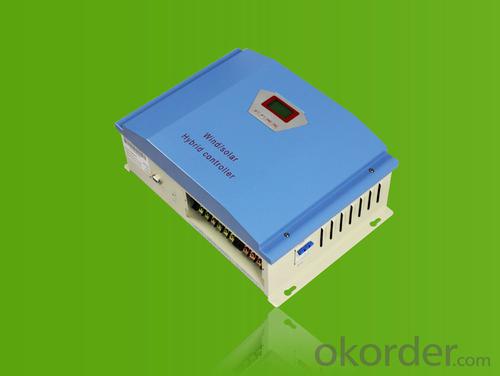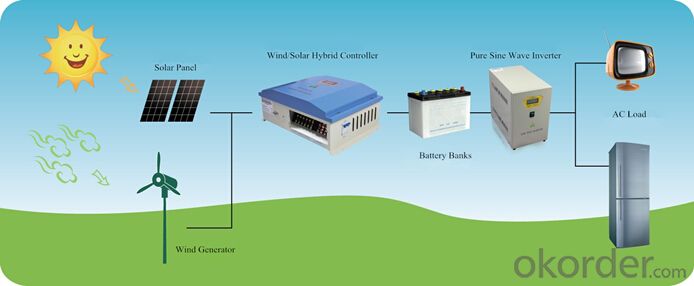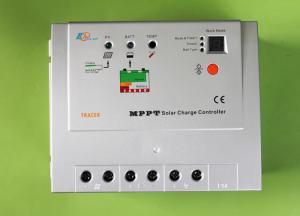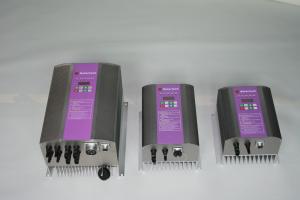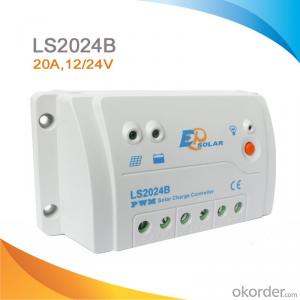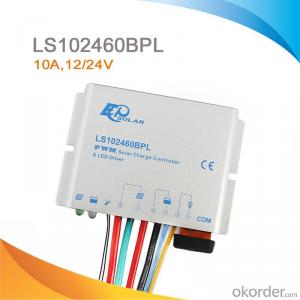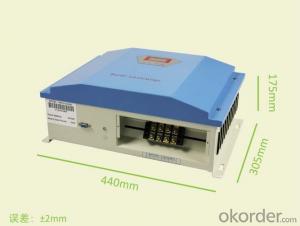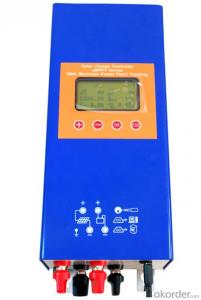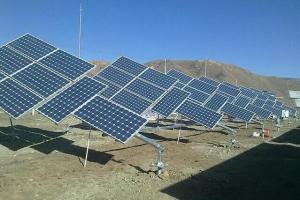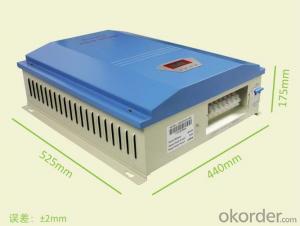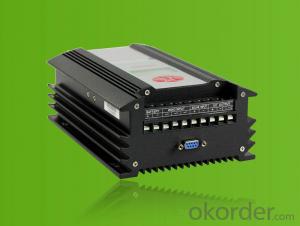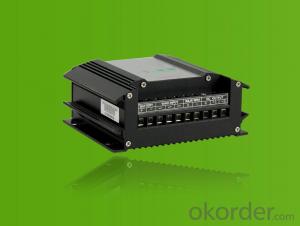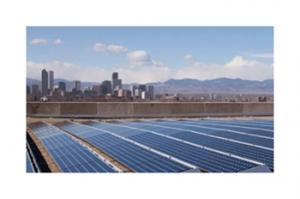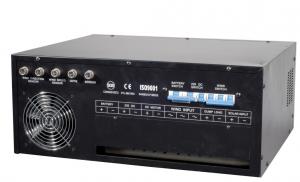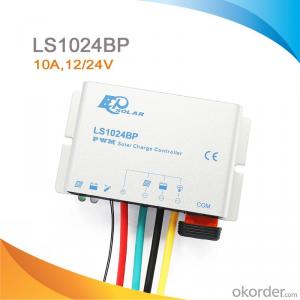Solar Street Light Controllers:2kW Wind Solar Hybrid PWM Stepless Unload Mode Controller
- Loading Port:
- Shanghai
- Payment Terms:
- TT or LC
- Min Order Qty:
- 1 unit
- Supply Capability:
- 5000 unit/month
OKorder Service Pledge
OKorder Financial Service
You Might Also Like
I. PRODUCT INTRODUCTION
The wind/solar hybrid controller is the control device which can control wind turbine and solar panel at the same time and transform wind and solar energy into electricity then stores to the battery bank.Wind/solar hybrid controller is the most important part in off-grid system, whose performance has much effect on life expectancy and operational stability of the whole system, especially the battery expectancy. Or battery service life will be shortened by over-charge or over-discharge.
II. PERFORMANCE FEATURES
Superior military-grade components to ensure the product stability.
Perfect protection function, thus the system has higher reliability.
Check and set all operation parameters as requirement from LCD display.
Voltage limiting and current-limiting charge mode ensures battery in the best charging status.
PWM stepless unload mode, which burn the excess power into dump load, making the battery charging in best status.
III. APPLICATION AREAS
Stand alone wind/solar hybrid power station; Stand alone domestic household wind/solar hybrid power system.
Mobile communication base stations, expressway and other non-residential regions.
Coastal islands, remote mountainous, border posts for regions shortage of or without electricity.
Government demonstration projects, landscape lighting project.
IV. 2KW TECHNICAL PARAMETERS
Product Model | WWS20-48 | WWS20-96 | WWS20-110 | WWS20-120 | WWS20-220 |
Rated Battery Voltage | 48V | 96V | 110V | 120V | 220V |
Rated Wind Turbine Input Power | 2kW | 2kW | 2kW | 2kW | 2kW |
Maximum Wind Turbine Input Power | 3kW | 3kW | 3kW | 3kW | 3kW |
Wind Turbine Brake Current | 42A | 21A | 19A | 17A | 10A |
Rated Solar Input Power | 0.6 kW | 0.6 kW | 0.6 kW | 0.6 kW | 0.6 kW |
Floating Charging Voltage | 58V | 116V | 133V | 145V | 266V |
Dimension(L x W x H) | 442×425×172 mm | ||||
Net Weight | 11.5 kg | ||||
Display Mode | LCD | ||||
Cooling | Fan | ||||
Protection Level | IP20(Indoor) | ||||
Quiescent Current | ≤20 mA | ||||
Protection functions | Battery over charge; Battery over discharge; solar reverse charge protection; anti-reverse-connection protection; wind turbine over rotate speed protection; wind turbine over wind speed protection; wind turbine over voltage protection; wind turbine over current protection; manual brake protection; automatically brake protection; lightning protection. | ||||
Ambient Temperature | -20~+55℃ | ||||
Ambient Humidity | 0~93%,without condensing | ||||
Working Altitude | ≤4000m | ||||
In order to serve our customers better. Our company can adjust parameters configuration according to customer’s requirement. | |||||
- Q: Can a solar controller be used in both residential and commercial applications?
- Yes, a solar controller can be used in both residential and commercial applications. Solar controllers are designed to regulate and optimize the charging of batteries in solar power systems, regardless of the scale or purpose of the installation. They can be used in small residential setups as well as larger commercial systems, providing efficient control and protection for solar panels and batteries in both settings.
- Q: What is the maximum output voltage for a solar controller?
- The maximum output voltage for a solar controller typically depends on the specific model and its design specifications. However, in most cases, solar controllers have a maximum output voltage of around 12 to 24 volts.
- Q: How do I install a solar controller?
- To install a solar controller, follow these steps: 1. Identify the suitable location for the controller near your solar panels and battery bank. 2. Mount the controller securely using screws or brackets. 3. Connect the positive and negative terminals of your solar panels to the corresponding terminals on the controller. 4. Connect the positive and negative terminals of your battery bank to the corresponding terminals on the controller. 5. Ensure all connections are tight and secure. 6. Finally, double-check the wiring and make sure everything is properly connected before switching on the controller.
- Q: Can a solar controller be used with solar-powered RVs or boats?
- Solar-powered RVs or boats can indeed utilize a solar controller. In fact, it is highly advisable to employ a solar controller in these scenarios to regulate battery charging and avoid overcharging. Acting as an intermediary between the solar panels and batteries, a solar controller guarantees the efficient storage of energy produced by the panels in the batteries. By controlling the voltage and current entering the batteries, it aids in preventing battery damage and extending their lifespan. Moreover, solar controllers commonly come equipped with features such as temperature compensation and battery protection, rendering them particularly suitable for RVs or boats where battery health and performance are of utmost importance.
- Q: Can a solar controller be used with solar-powered water desalination systems?
- Yes, a solar controller can be used with solar-powered water desalination systems. A solar controller helps regulate and optimize the charging of the batteries that power the desalination system, ensuring efficient energy utilization and preventing overcharging. This allows for seamless integration of the solar panels and the desalination system, maximizing the use of renewable energy for water purification.
- Q: Which is more efficient: PWM solar controller or MPPT solar controller?
- The MPPT (Maximum Power Point Tracking) solar controller is more efficient compared to the PWM (Pulse Width Modulation) solar controller. MPPT controllers are designed to optimize the solar panel's output by constantly tracking and adjusting the operating point to maximize power production. This results in higher efficiency and better utilization of the available solar energy. In contrast, PWM controllers regulate the charging process by switching the solar panel output on and off, which can lead to some energy loss and reduced efficiency.
- Q: How does a solar controller prevent overvoltage in the system?
- A solar controller prevents overvoltage in the system by continuously monitoring the voltage output from the solar panels. When the voltage exceeds a predetermined threshold, the controller reduces the charging current, limiting the flow of electricity into the batteries. This effectively prevents overcharging and protects the system from potential damage caused by overvoltage.
- Q: Can a solar controller be used with solar-powered water pumps?
- Yes, a solar controller can be used with solar-powered water pumps. A solar controller helps regulate the flow of electricity from the solar panels to the water pump, ensuring efficient and optimal operation of the pump. It can also protect the pump from damage caused by overvoltage or other electrical issues.
- Q: Can a solar controller be used with different types of solar panel grounding systems?
- Different types of solar panel grounding systems can be used with a solar controller. The solar controller's responsibility is to regulate the flow of electricity between the solar panels and the battery or grid. It typically includes safety measures to ensure the solar panel system's efficiency and safety. The grounding system is essential for the installation's safety. It provides a safe path for electrical currents in case of a fault or lightning strike. There are various grounding systems available, including grounding through the mounting structure, dedicated grounding conductor, or the building's electrical system. Regardless of the grounding system type, the solar controller's primary function is to manage battery charging and discharging or electricity flow to the grid. It doesn't directly interact with the grounding system. Hence, a solar controller can be used with different grounding systems without any issues. However, it's crucial to design and install the grounding system according to local electrical codes and regulations. This ensures the safety and reliability of the entire solar panel system. It's recommended to consult with a certified electrician or solar installer to ensure proper grounding practices are followed.
- Q: What is the maximum charging current that a solar controller can handle?
- The maximum charging current that a solar controller can handle depends on the specific model and specifications of the controller. Generally, solar controllers are designed to handle a range of charging currents depending on the size and capacity of the solar system. The maximum charging current is usually mentioned in the product specifications or user manual provided by the manufacturer. It can vary from a few amperes for smaller controllers used for smaller solar systems, to several hundred amperes for larger controllers used in larger solar installations. It is important to consider the maximum charging current when selecting a solar controller to ensure that it can handle the current generated by the solar panels and meet the charging requirements of the battery system. Exceeding the maximum charging current limit of a solar controller can potentially damage the controller or the connected battery system. Therefore, it is recommended to carefully review the product specifications and consult with the manufacturer or a solar professional to determine the appropriate solar controller for a specific solar system.
Send your message to us
Solar Street Light Controllers:2kW Wind Solar Hybrid PWM Stepless Unload Mode Controller
- Loading Port:
- Shanghai
- Payment Terms:
- TT or LC
- Min Order Qty:
- 1 unit
- Supply Capability:
- 5000 unit/month
OKorder Service Pledge
OKorder Financial Service
Similar products
Hot products
Hot Searches
Related keywords
